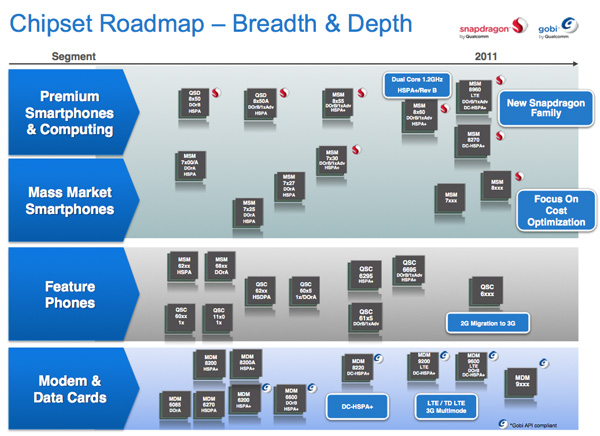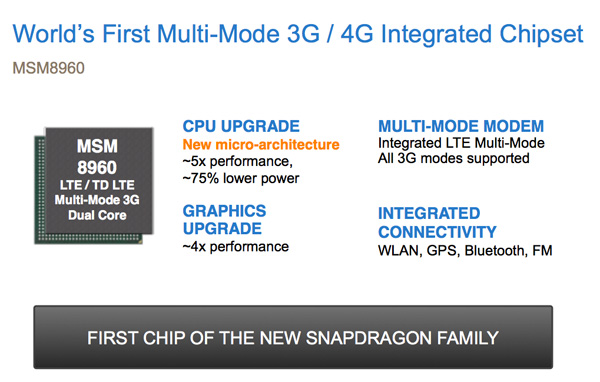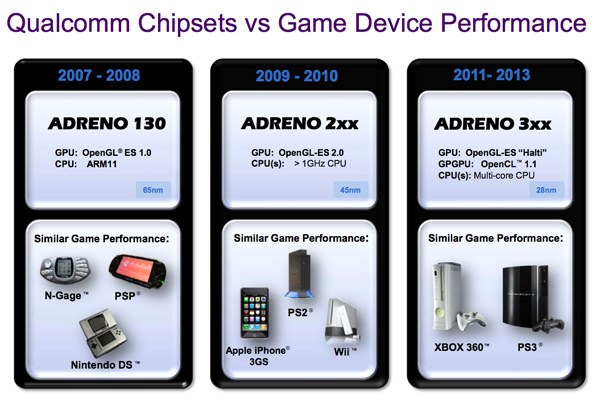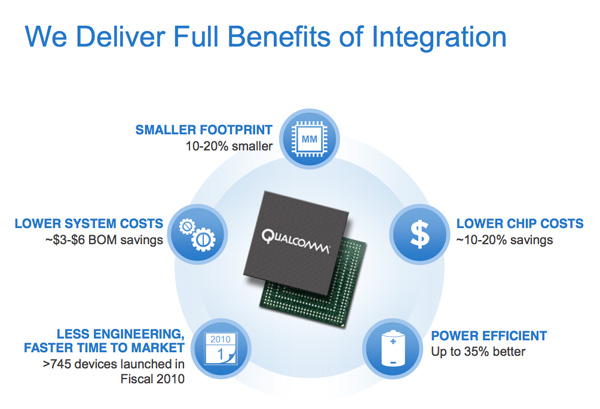Qualcomm Reveals Next-Gen Snapdragon MSM8960: 28nm, dual-core, 5x Performance Improvement
by Anand Lal Shimpi on November 17, 2010 11:00 PM EST- Posted in
- Smartphones
- Snapdragon
- Qualcomm
- MSM8960
- Adreno
- Mobile
- SoCs
Earlier today Qualcomm briefed analysts on its Snapdragon SoC roadmap. The current Snapdragon is available in both 65nm and 45nm versions integrating a single Scorpion CPU core running at up to 1GHz and an Adreno 200 or 205 GPU (respectively). Snapdragon was the SoC of choice for many Android phones over the past year and a half, not to mention the only SoC available in Windows Phone 7 devices.
In the coming months we’ll see the first dual-core Cortex A9 based NVIDIA Tegra 2 SoCs ship in devices. Sometime next year we’ll see A9 based OMAP4 SoCs in smartphones as well. So what does Qualcomm have in store for us over the next few years?
First we have the MSM8260 and 8660 SoCs. These are based on Qualcomm’s current generation technologies: integrating two Scorpion cores and an Adreno 205 GPU on a single 45nm die. The 8260 features HSPA+ support, while the 8660 supports HSPA+, CDMA2000 and 1xEV-DO Rev. B. These two dual-core SoCs will run at 1.2GHz. We should see a GPU upgrade here as well.
The 8x60 SoCs started sampling over the summer and we should expect to see them in high end smartphones sometime in 2011 at the earliest.
More exciting however is what comes next. Today’s disclosures included further details for the next-generation Snapdragon SoC built on a 28nm process. The first member of the next-gen Snapdragon family is the Qualcomm MSM8960 SoC.
Inside the MSM8960 are two next-generation processor cores, presumably out-of-order as Qualcomm is promising 5x the performance of the original Snapdragon chip (2x for the move to dual cores and the rest due to OoO, larger caches and other architectural tweaks perhaps?). Qualcomm isn’t disclosing clock speed at this time.
Power consumption is said to be 75% lower, however that seems very aggressive compared to what we have today. It’s unclear if Qualcomm is talking about active or idle power, or what version of Snapdragon it is comparing to (65nm or 45nm).
On the GPU side Qualcomm is making significant performance claims as well. The MSM8960 is set to offer a ~4x improvement in graphics performance. Again, Qualcomm wasn’t specific about what the reference point was. If it’s compared to the Adreno 200, that would imply a doubling of the GPU performance we have today.
Qualcomm has separately announced that the Adreno 3xx GPU would be used in SoCs from 2011 - 2013 on a 28nm process. This appears to be the GPU family used in the next-generation Snapdragon. Even more interesting is Qualcomm stating that Adreno 3xx will have performance similar to the Xbox 360/PS3.
If that’s indeed the level of graphics performance we’ll see in the next 3 years, being able to play Xbox 360 titles on Windows Phone 8 may not be too far fetched.
The 8960 continues to be a single chip solution with integrated modem, supporting all 3G modes as well as LTE. The MSM8960 will begin sampling in 2011, meaning we likely won’t see smartphones based on it until 2012.




















48 Comments
View All Comments
numbertheo - Wednesday, November 17, 2010 - link
For what definition of similar? The 360/PS3 GPU's have 300+ Million transistors.lehtv - Thursday, November 18, 2010 - link
What about transistor counts of iPhone 3GS vs Wii or PS2?numbertheo - Thursday, November 18, 2010 - link
I can't find any specific number. However, the A4 is 200M transistors and Tegra 2 is 260M transistors. For both of these, the vast majority of the chip is not taken up by graphics. Lincroft which has 140M transistors and uses the SGX 535 (sort of) has a pretty clear dieshot available. The graphics portion is clearly less than 1/4 of the die.I cant find any info on the Wii but the PS2 GS has 42.7M transistors (7.5M logical). The large difference is because it's memory was on die.
I'm sure that they could build a chip with 360/PS3 performance at 28nm at reasonable cost. I just don't think something like that will meet the power requirements of a phone.
skydrome1 - Thursday, November 18, 2010 - link
It's possible since the shrink to 28 nm will allow a more than doubling of the number of transistors in the same die space. Take 45 and divide it by 28 (comparison on number of transistors length wise) and square the answer to get number of transistors per unit of area. The answer is above 2, meaning more than twice the current number of transistors on the 45nm process.So 300 million transistors for the GPU sounds pretty possible. Then factor in architectural enhancements and what nots and the performance of an Xbox 360 or PS3 is actually quite possible.
B3an - Saturday, November 20, 2010 - link
Well it's worth noting that the GPU in the Samsung Galaxy S is already capable of pushing 90 million triangles, thats getting near to half of what the PS3 can do (250M triangles). The Xbox360 can do around 500M.The GPU in the Nexus One can do 22M.
The iPhone 3GS can do 7M.
Not sure about the iPhone 4 but i know it's nowhere near the 90M of the Galaxy S.
I think it's certainly possible to have a 28nm chip that can do around 250M triangles and use no more power than what a Galaxy S SoC uses.
Visual - Thursday, November 18, 2010 - link
I guess the catch is in the different resolutions that they work in. Probably the phones can match a PS3 in FPS when the phone has 480 line screen and the ps3 is working on 1080p, but if you used the tv-out of the phone, you'll likely still be quite disappointed.therealnickdanger - Thursday, November 18, 2010 - link
PS3 and Xbox 360 are both realistically 720p machines that can always output (upsample) to 1080p. Very few games actually render in 1080p and most of those are Arcade titles with simple graphics. There are exceptions, of course, but very few.When you consider that the PS3 basically uses a GeForce 7900GT and the 360 basically uses a Radeon X1900, that's five generations of graphics ago. By the time we see the Adreno 3xx in use, IGPs on PCs will easily best PS3/360 graphics (@720p), so it's reasonable to expect Adreno to to "similar" to PS3/360 graphics by that point. I doubt we'll see intense shader calculations, but most high-end phones in the coming years will have 720p screens as a minimum, so we'll at least get the resolution and frames per second. Will it look as good on my 60" plasma? Probly not.
ltcommanderdata - Thursday, November 18, 2010 - link
Seeing Qualcomm's definition of "similar" for the Adreno 130 includes both the Nintendo DS and PSP, which is a very wide performance range, their definition of similar could mean anything.Guspaz - Thursday, November 18, 2010 - link
Consider that Adreno 2xx series (the Adreno used to be the AMD Imageon) has a reputation for being notoriously slow, and that they've made their 4x performance improvement claims in the past (the Adreno 205 was supposed to be 4x the speed of the 200, and yet *both* are outperformed by the PowerVR SGX 540 despite the fact that the PowerVR SGX 540 competed with the 200, not 205...Snapdragon has earned a reputation of pathetic GPU performance. It'll take a lot more than some powerpoint slides to convince me that they've fixed the problem.
kenyee - Thursday, November 18, 2010 - link
Similar performance if playing Tetris... :-)